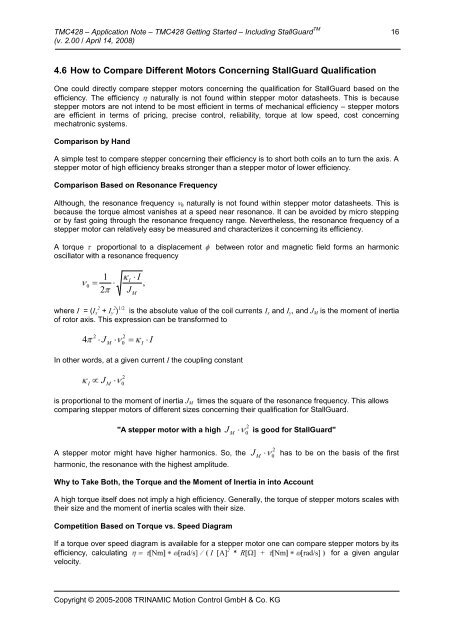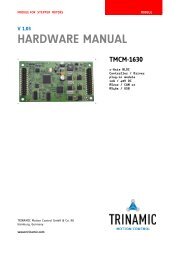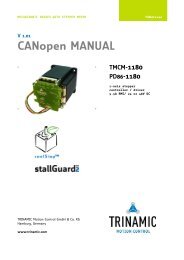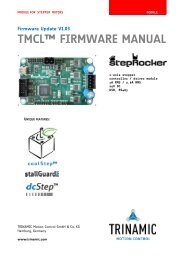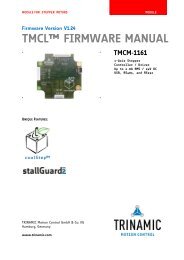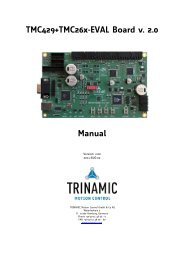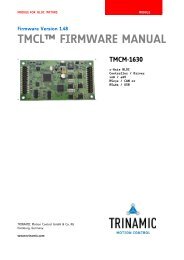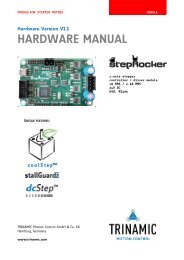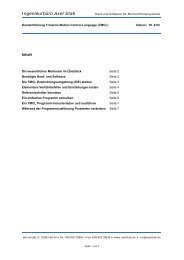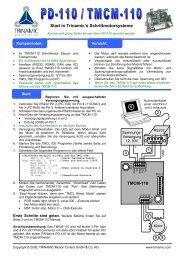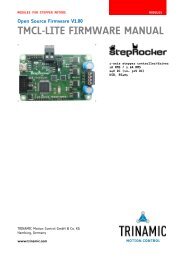TMC428 – Application Note - Trinamic
TMC428 – Application Note - Trinamic
TMC428 – Application Note - Trinamic
You also want an ePaper? Increase the reach of your titles
YUMPU automatically turns print PDFs into web optimized ePapers that Google loves.
<strong>TMC428</strong> <strong>–</strong> <strong>Application</strong> <strong>Note</strong> <strong>–</strong> <strong>TMC428</strong> Getting Started <strong>–</strong> Including StallGuard TM 16<br />
(v. 2.00 / April 14, 2008)<br />
4.6 How to Compare Different Motors Concerning StallGuard Qualification<br />
One could directly compare stepper motors concerning the qualification for StallGuard based on the<br />
efficiency. The efficiency naturally is not found within stepper motor datasheets. This is because<br />
stepper motors are not intend to be most efficient in terms of mechanical efficiency <strong>–</strong> stepper motors<br />
are efficient in terms of pricing, precise control, reliability, torque at low speed, cost concerning<br />
mechatronic systems.<br />
Comparison by Hand<br />
A simple test to compare stepper concerning their efficiency is to short both coils an to turn the axis. A<br />
stepper motor of high efficiency breaks stronger than a stepper motor of lower efficiency.<br />
Comparison Based on Resonance Frequency<br />
Although, the resonance frequency naturally is not found within stepper motor datasheets. This is<br />
because the torque almost vanishes at a speed near resonance. It can be avoided by micro stepping<br />
or by fast going through the resonance frequency range. Nevertheless, the resonance frequency of a<br />
stepper motor can relatively easy be measured and characterizes it concerning its efficiency.<br />
A torque proportional to a displacement between rotor and magnetic field forms an harmonic<br />
oscillator with a resonance frequency<br />
0<br />
1<br />
2<br />
I<br />
J<br />
M<br />
I<br />
,<br />
where I = (Ix 2 + Iy 2 ) 1/2 is the absolute value of the coil currents Ix and Iy, and JM is the moment of inertia<br />
of rotor axis. This expression can be transformed to<br />
4<br />
2<br />
2<br />
JM 0 I<br />
In other words, at a given current I the coupling constant<br />
I J M<br />
2<br />
0<br />
I<br />
is proportional to the moment of inertia JM times the square of the resonance frequency. This allows<br />
comparing stepper motors of different sizes concerning their qualification for StallGuard.<br />
"A stepper motor with a high<br />
A stepper motor might have higher harmonics. So, the<br />
harmonic, the resonance with the highest amplitude.<br />
Copyright © 2005-2008 TRINAMIC Motion Control GmbH & Co. KG<br />
J is good for StallGuard"<br />
Why to Take Both, the Torque and the Moment of Inertia in into Account<br />
M<br />
2<br />
0<br />
J has to be on the basis of the first<br />
A high torque itself does not imply a high efficiency. Generally, the torque of stepper motors scales with<br />
their size and the moment of inertia scales with their size.<br />
Competition Based on Torque vs. Speed Diagram<br />
If a torque over speed diagram is available for a stepper motor one can compare stepper motors by its<br />
efficiency, calculating Nm [rad/s] I [A] 2 * R[ ] + Nm [rad/s] for a given angular<br />
velocity.<br />
M<br />
2<br />
0


